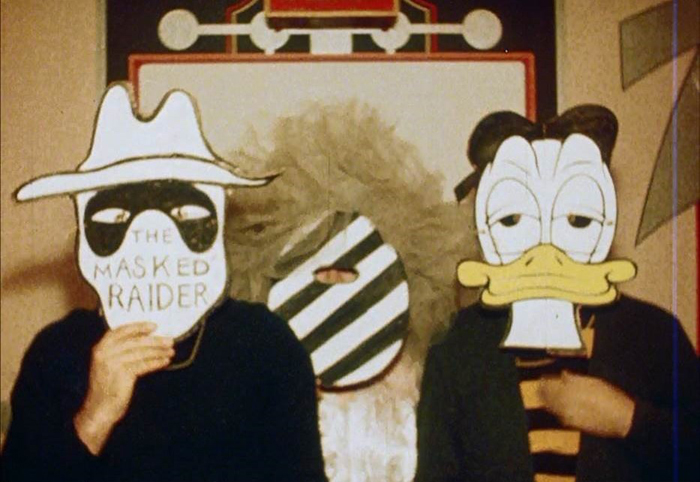Jeff Keen
Kate Macgarry & Hales, London, UK
Kate Macgarry & Hales, London, UK

The fantastic voyages conjured by the English filmmaker Jeff Keen whoosh straight out of his wild brain into the stratosphere. Crammed with junk, far brighter than the average funfair and sustained by a jet stream of sheer whimsy, his experimental films move at hellacious speed as though powered by the same far-out fuel that kept The Roadrunner whipping through the desert in Looney Tunes cartoons (1930–68).
Organized between neighbouring east London galleries Kate MacGarry and Hales, these concurrent exhibitions set Rayday Film (1968–70/76) and Cartoon Theatre of Dr. Gaz (1976–79) looping alongside sackfuls of Keen ephemera, photographs and paintings. Plastic lizards mix with silver robots in vitrines under the smoky gaze of Jackie, Keen’s wife, muse and star of many of his films, who appears in a few snaps, transformed by a thundercloud black wig and summer holiday face paint into a sultry lioness. Keen himself emerges not so much as the discombobulating eccentric you might first take him for, but an artist truly from the future, combining outré tastes from the European avant-garde – manic collages, freaky lusts, a fascination for garbage – with wonders from the pop culture circus of 20th-century America to create deranged entertainments that remain white hot.
A tester of experimental tanks and aeroplanes during World War II, Keen (who died in 2012 aged 88) first captured his brand of pandemonium on film in the 1960s – all gore, flash and racket. An enthusiastic participant in psychedelic London’s first ‘happenings’, Keen was one of the founders of the London Film-Makers’ Co-Operative. This countercultural shelter for creating and screening experimental cinema was critical to the artist’s career; Cartoon Theatre of Dr. Gaz (like many more of his works) was made under the Co-Op’s auspices.
If you crave total nerve-jangling lunacy, Keen is your man: his montages will turn even the most robust theoretician into a flummoxed jelly whilst treating their ears to a soundtrack of gibberish and intergalactic surface noise. So much is stuffed into Cartoon Theatre of Dr. Gaz that it causes vertigo, making you feel like Mickey Mouse in his battle against those pesky proliferating brooms in ‘The Sorcerer’s Apprentice’ sequence from Fantasia (1940): catch one marvel and another dashes past, tracking slime. Candyfloss-pink tongues slurpily explore severed legs, the titular tyrant from William Blake’s print Nebuchadnezzar (c.1795–1805) crawls past weeping blood; the ghost of King Kong plummets from the Empire State Building as some minx belches Superman into flight.
Thinking that the texture of modern life can only be conveyed through an experience of serious disorientation is, of course, a belief with a major history. Remember the dadaists: products of the mayhem of an earlier war who would have welcomed Keen into their gang with celebratory nonsense chants. Amid all the glee in Keen’s work, the spectre of the war rumbles away. You’d have to be knocked out not to feel the reverberations from blitzkriegs, machine-gun fire and nuclear bombs lurking within these films: they’re a ferocious attack. To use the slang of his youth, Keen was also a randy gentleman. Cock-like missiles routinely tumble from the heavens and a ‘doctors and nurses’ examination game is played with the nozzle of a vacuum cleaner: it’s a Hannah Höch tableau sprung to kinky life.
Such antics also suggest Keen as the resident alien on an American wavelength: his work could be situated somewhere between the oeuvre of Jack Smith – homemade, horny, anarchic – and Alex Bag’s career circa her public-access television series, Cash from Chaos and Unicorns and Rainbows (1994–97), which likewise record a hyperactive mind finding trippy sustenance in her homeland’s trashiest attractions.
But keeping inventory of all the American things, which appear like so many blow-up mascots floating over a Thanksgiving parade, risks ignoring the warped Englishness shaping all this stuff. Consider how, when Keen and his friends play superheroes, they sport joke shop fangs, lo-fi costumes and arched eyebrows: they’re Marvel Comics characters as brought to you by The Goon Show (1951–60) and Hammer Horror films. The whole thing’s a homegrown riot but Keen has his ray gun primed at a far mightier target than any caped crusader: the eye itself. Rayday Film is inaugurated with some magic jabberwocky about ‘tiger’s wings’, ‘a plastic octopus’ and an ‘eyeball skinned back to its haunches’. That would be a mighty symbol for his work, which is all about the frenzied pursuit of a more intoxicated way of seeing. Mission announced, Keen straps you to the rocket, blasting off as the echoes go crazy.
























